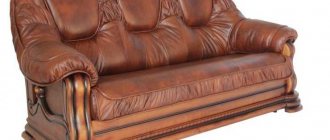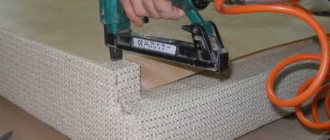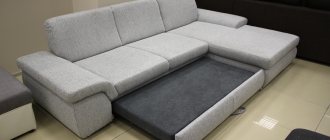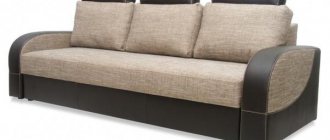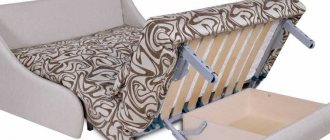How to sew a sofa with your own hands
After using the sofa for a long time, you can notice how some parts of it begin to tear. Most often these are the back and armrests. Sometimes the best option is to purchase a new new sofa, especially if the damage is very noticeable and the upholstery cannot be saved. But if the sofa is very dear to you, and the holes on it are small, then you can correct the situation with your own efforts.
In order to get started, you need to purchase a thermal fabric that matches the color of the upholstery (or vice versa, a bright shade if there is more than one hole and you want to create an interesting decorative effect on the sofa with the help of several patches).
Let's proceed directly to the restoration. First you need to cut out the patch of the desired shape and size. Next, you need to make a basting using a thread and a needle, and go over the resulting patch with an iron. You can patch a hole on the sofa using various pieces of fabric with or without bright patterns. This will allow you to create a truly unique design and update the boring look of upholstered furniture.
The patches can be placed randomly or strictly symmetrically, it depends on your imagination and on the overall design of the room, because everything should look harmonious and tasteful.
In order to correct the shape of the back cushions or armrests, you can use special pads. They can be either fabric or made of other materials, such as metal, wood or artificial stone.
“How to sew a sofa along the seams?” - you ask. This problem is very easy to solve. To fix everything, you need to choose a piece of fabric that matches the color of the sofa upholstery. Use knitting needles to straighten the fabric from the inside, carefully threading them through the slit. Then take a needle and thread and carefully sew first one side, then the other. Try to secure it as close to the slot as possible, gripping it end to end. Finally, run a blanket stitch around it. This will help prevent the fabric from tearing in the future.
How to make a patch for a sofa
For simple repairs, you don’t have to go to a workshop or rush to a furniture store.
Use quality leather for patches.
“But how can you fix a hole in a leather sofa yourself?” - you ask. It's really a little more complicated, but it can be done with minimal effort.
Any sofa becomes unusable over time.
We remember our sewing lessons at school, arm ourselves with scissors, a needle, and thread and get to work. The main thing in this matter is to correctly calculate the size. The main load falls on the allowances, so they must be larger than the damaged area.
Patches can be placed randomly or strictly symmetrically.
What materials can it be made from?
“Liquid skin” is very easily absorbed into the material.
We select materials for sofa repair according to convenience:
- thermal fabric;
- regular fabric;
- leather;
- "liquid skin".
The fabric for the upholstery can be any, but it is better to use a beautiful material.
The quickest and easiest way to make a patch is from thermal fabric. It can be the same color as the upholstery, but in case of multiple damages, contrasting options are acceptable. In this case, we arrange the stripes randomly.
A leather sofa requires special attention to restoration.
It happens that thermal fabric cannot be found, then we buy fabric for upholstery in the store. Choose one that matches the texture and color.
Suede fabric for furniture is an artificial material that has a velvety pile on the front side.
For leather furniture, we choose leather of a similar tone or special “liquid leather”.
Patch design or color
Classic style sofas should be repaired as discreetly as possible. The patch should not attract undue attention.
Choose the fabric for your sofa upholstery depending on your needs.
In modern models, and even more so if the general style of the room allows, you can “become mischievous.” Let's release our imagination and create. Patches can be:
- curly;
- colored;
- with characters and others.
If the damage to the sofa is serious, you will have to make efforts to restore it.
Creativity will help not only refresh the sofa, but also make it more relevant if the appearance of the “four-legged friend” is slightly outdated.
An old sofa can be completely remade.
Process of creation
First you need to carefully examine the sofa. It is more convenient to repair all the abrasions and holes at once. Having assessed the scale of the work ahead, we proceed to the preparatory stage.
The hole patch can be of any shape.
Making a patch yourself is quite simple. We take the selected fabric and measure the flap, cut out the desired shape.
Remember! It should be several centimeters larger than the damaged area in order to withstand the loads during further use.
Almost every happy owner of a leather sofa has faced the need for periodic restoration.
How to stitch up a cut on a leather sofa
If your leather sofa has small cracks, use a piece of leather of the same shade as the upholstery and push it through the center of each crack. It is worth noting that the piece of leather for the patch should be slightly thicker than the upholstery. This will maintain the elasticity of the fabric. Otherwise, new cracks may form.
It is recommended to place a piece of non-woven fabric under the leather patch. After finishing the work, sew up the area along the depressions. At the end, you need to lubricate the skin with a shine product.
You can also use a product called “liquid skin”. Choose it according to the color of the upholstery and use it this way:
- degrease the area of the sofa where you will apply the product; for this you can use a cotton swab dipped in alcohol;
- carefully place the “liquid skin” into the hole;
- take a clean napkin and press it on top;
- go over with an iron.
If you have perfectly chosen the desired shade, the hole will disappear instantly, leaving no trace. How does “liquid skin” work? The process of its operation is that it completely fills the hole and expands under the influence of high temperatures. This helps the sofa upholstery look seamless.
Elimination of defects using “Liquid Skin”
- Purchased in a store or market, the color is selected to match the upholstery;
- Degreasing the defect; for this you can use an alcohol solution, moisten a cotton swab in it and wipe the desired surface;
- Laying the material itself at the site of damage;
- Pressing down on top with a clean napkin;
- Walk over the sealed area with an iron.
With an ideally selected shade, not a trace remains of the hole, since the “liquid skin” begins to melt when exposed to high temperature, in our case this is an iron. After melting, all the smallest areas of the defect are filled, making the upholstery look like a solid covering.
How to disguise a hole
In order to outwardly hide damage to the upholstery, you can use a beautiful blanket or decorative cape. They can not only hide a hole, but also complement the appearance of the room, adding an interesting twist to it.
There are special covers that are sold in furniture stores. You can purchase several different types and change them to suit your mood. Moreover, such covers are very easy to care for.
If there is major damage, you should consider completely reupholstering the sofa. Masking methods in this case will be inappropriate. You can do this at home, or you can seek help from specialists. If you know how to handle tools and have free time and a desire to do something with your own hands, then take up reupholstery yourself. There is a lot of information and videos on the Internet on how to reupholster furniture yourself. Otherwise, professionals will do everything quickly and efficiently, but they will have to spend a certain amount of money.
How to sew up holes correctly: instructions
In order for your clothes to look neat and attractive, you need to carefully monitor their condition. Often things deteriorate because small puffs, grouts or holes appear on them. You can cope with every defect if you know a few rules. Step-by-step algorithm:
- Determine where the defect occurred.
- Study the quality of the fabric and the possibility of influencing it.
- Depending on the type of material and the degree of damage, choose a method to eliminate the problem.
- Select threads or patches. Prepare the tool for work.
Tools for repairing things
If you correctly evaluate and carry out all stages of repair, the product will receive a new life.
How to fix a hole in a jacket at the seam
If a seam on a jacket has unraveled, there will be no problems with repairing it if you use a special sewing technology. The restoration method is manual and does not require special skills in needlework:
- You need to choose the right threads. In this case, color does not matter, the main thing is texture and density. You can even use green thread, even when repairing a red jacket, since the new seam will be completely hidden.
- To accurately determine the area of work, you need to lay out the jacket on a flat surface.
- It is necessary to ensure that the end of the old seam matches the old one perfectly. Therefore, the first stitch is made from the inside to hide the knot.
- Next, alternate stitches are made that will connect the 2 sides.
- After the two parts of the jacket are completely connected, you need to tighten the thread. The seam will join and the sewing material will be hidden under the fabric.
You might be interested in this Traditional patterns of Russian folk embroidery
The principle of sewing up a seam on a jacket
This option will be suitable for repairing seams on jackets made of any material. This seam joining technique is ideal for restoring Bolognese sports jackets and down jackets.
How to sew a hole in a sweater
It seems that it is very difficult to restore a knitted sweater that has a hole in it. In fact, hiding a defect is quite simple. First you need to determine the location and visual perception of the hole. And then pick up the seam.
How to mend a hole in knitwear by hand if it is located on the fabric:
- Using sewing material identical in color to knitwear, you need to make several seams that will correspond to the direction of the main thread.
Note! The work is done from the wrong side to hide the knots and the thread itself.
- After forming several seams, the thread needs to be tightened a little to bring the edges of the hole closer.
- Then transverse suturing is performed. The thread must be pulled through the already formed stitches.
Repairing a knitted sweater
The result is a small patch that does not stand out on the knitted fabric. Even a child can carry out this type of repair.
How to repair a sock
You don't always have to darn your socks. Especially if it is a knitted material, and the damage is not on the heel and is not huge in size. Various repair techniques:
- You can use a hidden seam, as when repairing jackets. This option is relevant if the fabric has a ribbed print.
- A popular option is “darning”, which is used for repairing knitted sweaters.
Additional Information! In order not to deform the sock and keep your foot comfortable, you do not need to tighten the thread too much and choose a synthetic version of the material for work.
- If the hole is too large and in a visible place, then the only way is to sew on a patch.
Darning a sock
The variation of the technique depends on the color and design and print. The same principle can be used to repair leggings.
How to mend the heel of a wool sock
The only drawback of wool socks is the quick deterioration of the heel - the hole gets worn out. To repair an item, you can use 2 different methods:
- You can mend the hole using a sewing machine. To do this, you need to select a special pad in the kit, which is attached instead of the foot, and set the stitch to the minimum length. To carry out such repairs, you need special equipment and the ability to carry out such operations.
- The second option is simpler, but longer. You need to not only know how to sew, but also knit. It is necessary to cut off the uneven edges of the abrasion. Remove the yarn so that the loops stand out. Fix the knitting needles on them and knit the missing rows. Then, using a thread and a needle, sew the heel and elastic loops together.
You may be interested in What is cross stitch canvas: tips for choosing
Wool sock heel repair
In both the first and second cases, the product will look like new. The choice should be made in accordance with the size of the hole and the skills of the needlewoman.
Getting rid of holes in jeans
Jeans are a basic item in any wardrobe, so they are used more often than others. As a result, the material wears out quickly and holes appear.
Important! If the gap has formed on the knee or has the shape of a strip, then there is no need to get rid of it - this is a trend.
How to rid jeans of various holes:
- Sew a patch on the wrong side. Unravel the edges on the outside, forming a fringe.
- An appliqué made of fabric, leather and other materials can hide a defect.
- A sewing machine can be used to perform stitching - tightly sewing on a patch using small stitches in different directions.
- Figured embroidery. Pull the edges of the tear together and, using the principle of crocheting with a needle, form a beautiful seam or figure.
Patch on denim pants
Jeans is a dense and versatile material in terms of finishing, so you can choose any of the proposed options.
How to sew up a hole in the knee of sweatpants
Children's pants often require patch repairs in the knee area. How to sew up a hole in the knee of sweatpants depends on assessing the situation, but basically a patch is applied from a material that is suitable in texture or texture.
How to beautifully sew up a hole in the knee of jersey sweatpants:
- Cut a strip from the fabric, the length of which will correspond to the width of half the leg and the height to the dimensions of the damage.
- Apply the patch to the problem area. Secure it with safety pins.
- Sew the patch to the pant leg using any suitable seam.
Repairing knees on sweatpants
You can replace the entire damaged part in the same way. Cut off the damaged strip and sew in the same one, but from a different material.
How to fix a hole in a fabric sofa
Furniture restoration is considered a complex and expensive process, especially when it comes to replacing or repairing upholstery. You can cope with the task yourself. How to fill a hole in a fabric sofa for a designer look:
- Prepare patches from the selected material according to the shape of the holes or cuts.
- Place the blanks in problem areas and mark out the elements.
- Sew the blanks to the fabric base. Can be glued with a glue gun.
You might be interested in Diamond embroidery: technical features, sewing rules
There are methods for solving problems with leather upholstery options. Few people know how to repair a hole in a leather sofa, but it is possible:
- Clean the cut area.
- Fill the problem area with liquid skin.
- Remove any residue with a damp cloth.
- Iron through the fabric.
Repairing a leather sofa
These techniques will help extend the life of the furniture and make it look designer.
How to quietly sew up a hole in tulle
To “repair” tulle, you must first connect the edges with a thin thread of a suitable color. Be sure to connect small cells. To completely patch the problem, you need to apply a special web tape to the area. Iron the area through gauze.
How to repair a hole in raincoat fabric
The most difficult thing is to sew up raincoat fabric. The texture comes apart easily under the influence of a needle. There are several options:
- Use an invisible seam if you need to remove a defect in the connection of product parts.
- Glue the edges with textile glue. Cut off the frayed threads and fold the edges. Glue the parts together.
- Make a small patch of an interesting shape.
Option for restoring raincoat fabric
It is not advisable to sew the raincoat material, since the base may split again. It is better to use glue or adhesive bases.
Upholstery reupholstery
One of the best options for severely damaged sides of the sofa would be to cover them with new anti-claw material. Then the furniture will take on an updated look and will not suffer from excessive cat claw activity in the future. It can be any dense fabric with a smooth pile, for example, fleece, jacquard, velor, velvet, satin or faux suede.
You can make inserts in a contrasting color or to match, and also add original decor in the form of rivets, snakes or sisal rope if the interior is made in eco-style.
Super option for a leather sofa
For those who have furniture made of natural or high-quality artificial leather, damaged areas can be corrected using a special “liquid leather” paste. Before applying it, the surface of the sofa or chair is degreased with alcohol (using a cotton pad or cloth). Then the crack or torn area is filled with the utmost care with the solution.
The paste is pressed on top with a napkin and ironed so that the liquid evaporates. If the color of “liquid leather” is chosen correctly, the defect on the furniture will be completely invisible. The solution fills the entire cavity, and under the influence of high temperature it melts and becomes one with the original material of the furniture.
How to disguise a hole in a sofa?
Upholstery reupholstery
If we are dealing with large-scale damage, it is easier to think about rather than about methods for masking the hole. Today, reupholstering a sofa, although a troublesome task, is quite doable. If you know how to handle some tools, have enough free time, have the desire and patience to create, do everything yourself. Otherwise, it is better to entrust this work to a professional and enjoy the resulting result, without wasting a single nerve cell, but paying a substantial amount to the craftsmen for the work.
Cape
Emergency help in case of damage to the sofa can be the purchase of a blanket or cape that will cover the hole and prevent the hostess from feeling uncomfortable in the presence of guests.
Now let's look at ways to seal small holes in upholstery. Here you should start from the material with which the sofa will be upholstered.
"Liquid skin"
If we are dealing with a high-quality substitute, a special “liquid skin” solution is suitable, which is used as follows:
- the surface of the sofa should be degreased (moisten a cotton swab with alcohol and wipe the area where the paste will be applied);
- carefully place the paste into the hole;
- press the napkin on top;
- iron.
After this procedure, the hole should disappear before your eyes, especially if the color was well chosen. How is this possible? The fact is that the paste fills the hole and melts under the influence of high temperature. This makes the surface of the furniture look solid and undamaged.
Sewing
If the upholstered furniture is upholstered with one of them, then you can try to sew it up yourself. It is important to understand here that you cannot do without a patch, since if you start tightening the edges of the hole, you can make it even larger. Take a piece of similar material, insert it inside the hole and sew it in a circle. Keep your stitches small and hidden, and buy a needle and thread designed specifically for this purpose.
Dmitry Chief Technologist at HEGGI
If the hole is not large, then it can be sealed with special liquid leather or darned. But if the hole is larger than 5 cm, believe me, it’s better to reupholster your furniture.
The classic said that “nothing in the world lasts forever”! Unfortunately, this statement applies to absolutely all people dear to our hearts, as well as objects that mean a lot to us, including our favorite furniture that has surrounded us at home for many years.
Timely cleaning and disinfection of cabinet and upholstered furniture are mandatory elements. But there are situations when little depends on the owner of the product (one of the guests burned the sofa) or he notices complex contamination too late. A particularly unpleasant moment can be a hole in the upholstery of your favorite chair or expensive sofa!
How to fix a hole in a sofa?
If it is of considerable size, then it makes sense to think about completely replacing the upholstery material, but this process requires, as you well understand, the intervention of a professional, whose services can be expensive. At the same time, you don’t have to take your upholstered furniture to the workshop (this, by the way, is also an additional material expense) - today you have the opportunity to call a furniture craftsman to your home, where he will do his work.
Another solution to this problem is a regular blanket. Pick up a cover for upholstered furniture at your nearest textile store and cover the sofa seat with it. If neither one nor the other method suits you, then you can use the following useful recommendations. Fixing a hole in upholstered furniture primarily depends on what kind of upholstery material it is. It can be fabric, natural or artificial leather, suede and much more.
There are a considerable number of special solutions and devices designed specifically for removing damage from the surface of upholstered furniture. These include the so-called “liquid skin”. This special solution has the consistency of a paste. It is carefully placed in the hole on the sofa and pressed with a dry napkin. Then an iron is placed on it (1-2 seconds is enough). After these steps, the napkin is removed, and if the color of the “liquid skin” is chosen correctly, then in the place where there was a gaping hole a couple of minutes ago, nothing will be noticeable - the upholstery is like new! The principle of operation of this method is simple - the paste fills the hole and melts under the influence of high temperature, after which the surface looks solid and undamaged.
You can also try sewing up the upholstery hole yourself at home. How to sew up a hole in a sofa? - it’s not difficult, but only take on the task if you are confident in your abilities, otherwise you can ruin everything even more. Take a piece of the same or similar fabric to the upholstery and make a patch. Remember that the stitches should be small and “hidden” (invisible to the human eye). In this case, you need to use only special furniture accessories for sewing: threads, needles, etc.
Everyone likes change. If an old, but beloved and familiar sofa has worn out, and you have not yet saved up the money to buy a new one, you can update it by covering it with new beautiful upholstery. You need to figure out how to choose the material and then cover the sofa with your own hands.
If your sofa is worn out and looks ugly, then reupholstering it will be the way out of this situation.
You need to start with the main thing, without which it is impossible to start work, with tools and materials.
Lace or knitted patches
With such a patch, no one will guess that it was done intentionally to hide the damaged upholstery. It looks gentle, neat and original. You can knit decorative elements yourself or buy them. Before sewing them on, you need to process the material of the sofa: remove all protruding threads and “pellets” so that a smooth surface remains. After preparation, carefully sew the openwork parts to the place where the upholstery is torn.
An example of sofa repair with step-by-step photos
The old sofa became completely uncomfortable, began to sag in places and creak. There is no way to buy a new one, it was decided to reupholster and change the upholstery. As usual, reupholstering a sofa begins with disassembly. The legs were removed first. The railings were fastened with two large bolts; they were unscrewed and removed without any problems. Further disassembly is also not difficult - we unscrew the bolts that appear one by one.
When all the components were separated, the old upholstery was removed. The staples were easy to remove - the frame was made of pine timber. The spring block itself turned out to be without defects, but there was a crack in the frame, one of the frame beams sagged, the fiberboard sagged, although there were no cracks.
Frame repair
Since the frame bears the main load, it is better to replace damaged elements. We carefully measure them, draw them schematically, and put down the dimensions in millimeters. With the drawing we go to the carpentry shop. Please pay special attention: the wood must be dry, preferably kiln dried. If you know how to work with wood yourself, you can do it yourself.
It was decided to connect the frame, as it was, with a tenon/groove, coated with wood glue. But to prevent it from coming loose, the connection was reinforced with metal dowels.
First, the connections are glued and clamped in a vice. A small diameter hole is drilled under the dowel and the dowel is hammered in. The frame stands in a vice until the glue dries.
We will use 4 mm thick plywood as the base for the spring block. The sheets are standard, a little more than 1.5 meters, and the length of the sofa is almost two. It turns out two pieces. It is better to make the joint of the pieces on a jumper, it is more reliable. We cut out rectangles of the required size, coat the frame with wood glue, lay plywood, and nail it with small nails. The length of the nails is so that they do not stick out outside the frame. We additionally support the joint with a plank (50*20 mm).
The updated sofa will serve in the country house, so we try to keep the budget to a minimum; we use an old blanket instead of a backing for the springs. We stretch it well and fasten it with staples using a hand tool.
The base for the springs is an old fleece blanket
If possible, it is advisable to put thermal felt here. It is more reliable and not so expensive. It is cut to size, straightened and nailed around the perimeter. You can use staples or nails with large heads.
Repairing and fixing the spring block
To fasten the spring block, you can use powerful U-shaped brackets, and it is better if their legs are sharpened. But the stapler does not work with these, so we cut staples from steel wire with a diameter of 1.5 mm and hammer them in with a hammer.
In addition to being attached to the frame, the springs are also secured with nylon straps. Twine was taken, folded in two layers, secured with the same wire staples. We tighten the constriction so that it does not press down on the springs, but the tension should be sufficient so that the block “does not move.”
Some dense material should be placed on top of the springs, usually felt. In this case, old flooring was used. Something like felt. It is quite dense and durable. Fold in two layers, cut to size. This layer must be attached to the spring block. The coating is dense, you can’t pierce it with a needle, even a gypsy one. A large diameter awl would be suitable, but there isn't one. We pierce the coating with a nail, which we push through with the handle of a screwdriver. We thread a thick thread into the holes made. The stitch pitch is about 3.5 cm. To speed up the process, we use several nails at once.
Next “according to plan” there should be foam rubber, on top of which a padding polyester is placed. In this project, it was replaced with two layers of densely elastic material, which had been stored in the attic for a long time. Instead of padding polyester, another old blanket was used. To prevent the blanket from moving around, it was grabbed around the perimeter with threads (in conventional technology, synthetic winterizer is glued to polyurethane foam or latex using glue from a can).
Decorative cape
You can hide damaged areas of upholstery or protect new furniture from damage by animals using a beautiful blanket or a special decorative cape. The choice is multifaceted: contrasting, colored, plain or patterned colors. The cape not only performs a practical function, but is also able to reimagine the entire interior of the room in a new way, adding a special twist to it.
In the store you can choose a cover that covers the entire surface of the furniture. If you choose several options, you can change them according to your mood or every season so that the situation does not get boring. These covers are very easy to care for: they can be removed and washed.
How to restore a leather sofa at home - DIY leather furniture repair
Leather is an almost ideal material for furniture upholstery, because it is durable, beautiful, environmentally friendly, and presentable. But even the highest quality leather upholstery loses its inherent luster over time - during use it becomes dirty, begins to become unpleasantly greasy, and loses color saturation. No matter how carefully you handle, for example, a leather sofa, it can get scratched, become covered with a dirty coating, and stains. We will talk in more detail about how to update a leather sofa and other leather furniture below.
How to restore a leather sofa? Only a professional restorer can answer this question, because restoring a leather sofa is a complex process that requires special skills, experience, special compounds and tools. But you can make minor repairs to leather sofas and remove minor dirt and defects on your own.
You can easily clean leather furniture from various stains and dirt on your own. For example, marks from felt-tip pens, stains of juice, and wine are removed from the skin with a cloth soaked in pure alcohol. Attention! Aggressive solvents are not suitable for leather!
If you have stained a leather sofa with grease, you can cover the stains with talcum powder for two hours and then remove them with a dry cloth. Chewing gum stuck to the leather surface should first be frozen with a piece of ice and then carefully removed.
Scuffs and small scratches on leather upholstery can simply be painted over with a special composition for leather, these are sold in leather goods stores, but if the leather is slightly torn, it can be sealed with a “liquid leather” product.
Let's take a closer look at how to repair a leather sofa in case of minor damage.
Beautiful patch
You can repair the damage caused by pets with the help of imagination and embroidery thread. This stylish analogue to conventional stitching will provide furniture with a stylish and exclusive design without extra costs. The threads can be matched to the sofa or in a contrasting color. The choice of pattern also has no frames: abstraction, floral patterns, flowers or geometry.
Patchwork - stylish and relevant
Patchwork or patchwork is an easy way to reliably disguise any imperfections in the upholstery. It can be made from any leftover fabric you can find at home. We select a beautiful option by color, sew the required number of pieces of fabric and voila!
If the upholstery is badly damaged, you can create a bright cape in this style - it won’t take much time and will significantly save the family budget.
Creative solution - mosaic
Mosaics can be used not only for walls, but also for furniture decoration. It has a self-adhesive base, so it is very convenient even for beginners. Before updating the upholstery, it is secured with a construction stapler so that the base is strong. After this, worn-out parts of the furniture are sealed with a plain mosaic or a picture with any ornament.
Did you like the article? Then support us, click
:
How to remove scorch marks from sofa upholstery? How to remove cigarette holes from a sofa?
USEFUL! Becoming slim has become very easy. “HOUSE 2” For the sake of returning to the project, I lost 25 kg! . More details here
Buying a new sofa is always a joyful event, but what to do if friends came to wash the new thing, accidentally dropped a plate of Olivier, spilled wine and coffee, and left burnt spots on the sofa? Don’t throw it away, of course, but try to correct the situation after the guests leave, but how? If food stains can still be cleaned out somehow, then what to do with a neat round hole burned by a cigarette all the way to the foam?
Let's talk about scorch marks on the upholstery
Not every upholstery fabric for upholstered furniture is particularly resistant to stains, although Teflon impregnation can repel liquids, and many liquids do not stain at all on leatherette. However, it also happens that when you try to clean the stain and dry the upholstery with an iron, a new problem appears - a scorch mark, which is even more difficult to remove than the previous stain from food contamination.
Burnt spots on the upholstery of upholstered furniture also appear on the upholstery for other reasons:
- the sofa or chair was too close to the stove or fireplace;
- there is a habit of ironing things on the sofa;
- the electric fireplace is close to the sofa;
- I have a habit of smoking on the sofa, etc.
All this can not only ruin the sofa, but also cause a fire in the house. Different types of upholstery have their own thermal impact threshold, therefore, with the same thermal impact, some furniture fabrics do not react in any way, others turn red, others ignite, and some smolder or melt from a cigarette, but do not burn. The degree of destruction of the fibers will vary, but in many cases something can be corrected.
Scratches, cracks, holes on a leather sofa: how to fix
Before choosing a way to repair a leather sofa, it is worth finding out what material the furniture is made of and how great the degree of damage is.
Different types of leather upholstery for upholstered furniture require different approaches. For furniture, pigmented, aniline leather and split leather are used.
- Pigmented is the most popular. It is durable, scratch-resistant, and does not absorb liquids.
- Aniline leather has no protective coating and retains its natural texture. This is an expensive, high-quality, and therefore rare material.
- Split leather is a cut inner layer of low quality leather, which is coated on the outside with a protective polyurethane coating.
Repair and restoration methods are chosen depending on the depth of damage. In case of minor abrasions or scratches on pigmented leather, the damage can simply be covered with a special paint for natural leather material.
If only the surface layer of the upholstery is damaged, you can use a color-matched permanent marker for masking. The material is first cleaned and dried, then the scratch is painted over several times. You can use clear nail polish, vegetable oil, lanolin, but the results will not last long.
Aniline leather and split leather can be restored using the thermal method. Cover the scratch with a damp cloth and heat it with a hairdryer or warm iron, applying it for 10 seconds. When exposed to heat, the leather covering will give up its natural oils and pigment, and the scratch will be filled.
If the inner layer of the material is also damaged, use the “liquid skin” product. The most radical method of repair is to reupholster a sofa or chair with your own hands.
Ways to remove scorch marks on sofa upholstery:
- If the surface of the destructive thermal effect is small, try to treat this area in several ways. For example, in many cases, hydrogen peroxide on a napkin with a few drops of ammonia helps.
- Often it is enough to wipe away a fresh iron stain or scorch with a damp cloth with vinegar or another acidic medium, such as whey, this is how a tapestry used to be saved.
- Colored fibers are sometimes restored the old-fashioned way - rub the scorch with an onion, and then wash it with a clean sponge.
- A fresh reddish stain on a white fabric can be easily removed by applying a wet towel soaked in a solution of chlorine bleach - white.
- Lemon rubbed into the upholstery stain also works well for this task, after which the area is covered with coarse salt and actively scrubbed with a brush, and then wiped with a wet towel.
- Some stain removers also do a good job of this task, but before treating with any product, it is important to clarify the type of fabric and those reagents that are recommended to be used or, conversely, prohibited.
What to do with thoroughly damaged upholstery?
The degree of destruction of furniture upholstery varies, but you can always try to solve the problem.
- You can try to patch a large area of burnt upholstery, if you have something. For example, most new sofas come with a small piece of material that covers the upholstered furniture. The easiest way to patch faux fur that has been singed in a small area. To do this, you need to cut out the burnt fragment a little wider than the hole with the sharp ends of small scissors, since the pile around it is probably damaged. It is best to cut out a circle or square, and cut out a similar piece on a spare piece, using a cutting blade from the inside out.
Next, you will need another piece of larger diameter, which we will place under the hole, and the edges of the upholstery on the back side will be greased with PVA glue and pressed down well. When the base is glued, carefully place a patch (square or round) on the prepared place, greased with PVA on the back side and also press down well. When the patch is fixed, it is important to comb the edges of the fur patch and the joint with the rest of the upholstery well in different directions to remove the border. The defect is not noticeable at all if the piece fits exactly, but if there is a pattern and it exactly matches the base, even better. Sometimes you have to use sofa cushions for this purpose.
- Artificial and natural suede with weeds not down to the base, only on the surface, can be restored with ordinary sandpaper. Try rubbing a piece of sandpaper over the area to remove any fire-damaged particles. In most cases, the stain leaves no traces. And sometimes you have to do a partial or complete reupholstery of the sofa when the affected area is too large and the fabric cannot be restored.
Contact the professionals!
If you have doubts about your own competence or funds, it is better not to risk such an expensive thing as a leather sofa. And the specialists of the Fenice-TM company can deal with holes, abrasions and other leather defects without risk. Unique Italian technology, appropriate equipment and materials allow you to obtain ideal results at minimal cost.
The Fenice-TM company offers:
- crack putty,
- polishing the leather.
And if the sofa, according to experts, is not subject to cosmetic restoration, you can save it with a radical measure - changing the upholstery. The professionals of our company will help you create a new leather outfit for a sofa, armchairs and any other interior items. Contact us!
Dmitry Chief Technologist at HEGGI
If the hole is not large, then it can be sealed with special liquid leather or darned. But if the hole is larger than 5 cm, believe me, it’s better to reupholster your furniture.
The classic said that “nothing in the world lasts forever”! Unfortunately, this statement applies to absolutely all people dear to our hearts, as well as objects that mean a lot to us, including our favorite furniture that has surrounded us at home for many years.
Timely cleaning and disinfection of cabinet and upholstered furniture are mandatory elements. But there are situations when little depends on the owner of the product (one of the guests burned the sofa) or he notices complex contamination too late. A particularly unpleasant moment can be a hole in the upholstery of your favorite chair or expensive sofa!
How to fix a hole in a sofa?
If it is of considerable size, then it makes sense to think about completely replacing the upholstery material, but this process requires, as you well understand, the intervention of a professional, whose services can be expensive. At the same time, you don’t have to take your upholstered furniture to the workshop (this, by the way, is also an additional material expense) - today you have the opportunity to call a furniture craftsman to your home, where he will do his work.
Another solution to this problem is a regular blanket. Pick up a cover for upholstered furniture at your nearest textile store and cover the sofa seat with it. If neither one nor the other method suits you, then you can use the following useful recommendations. Fixing a hole in upholstered furniture primarily depends on what kind of upholstery material it is. It can be fabric, natural or artificial leather, suede and much more.
There are a considerable number of special solutions and devices designed specifically for removing damage from the surface of upholstered furniture. These include the so-called “liquid skin”. This special solution has the consistency of a paste. It is carefully placed in the hole on the sofa and pressed with a dry napkin. Then an iron is placed on it (1-2 seconds is enough). After these steps, the napkin is removed, and if the color of the “liquid skin” is chosen correctly, then in the place where there was a gaping hole a couple of minutes ago, nothing will be noticeable - the upholstery is like new! The principle of operation of this method is simple - the paste fills the hole and melts under the influence of high temperature, after which the surface looks solid and undamaged.
You can also try sewing up the upholstery hole yourself at home. How to sew up a hole in a sofa? - it’s not difficult, but only take on the task if you are confident in your abilities, otherwise you can ruin everything even more. Take a piece of the same or similar fabric to the upholstery and make a patch. Remember that the stitches should be small and “hidden” (invisible to the human eye). In this case, you need to use only special furniture accessories for sewing: threads, needles, etc.
Elena Chief designer of HEGGI
There is upholstered furniture in every home. Such interior items are expensive, so it is important to pay a lot of attention to their care, because they are not changed every season. The sofa is designed to serve its owners faithfully for many years. But there are situations in which it is difficult to blame anyone, because anyone can make a mistake and accidentally ruin the upholstery with a drink, food that will leave a greasy stain on the furniture, or a cigarette that will completely burn through it.
We offer you several methods designed to return the sofa to its original appearance and cheer up the mistress of the house, because it is usually the fair half who is upset about this.
Useful tips
Whatever the impact of the burnt spot, try to damage the fibers or base of the furniture upholstery as little as possible so that its structure is not damaged. Whatever your experience, don’t despair; you can always sew a regular patch on the hole. You can always cover upholstered furniture with a sofa deck, slipcover or blanket. As a last resort, you can reupholster the sofa, but just don’t throw it away.
USEFUL! Becoming slim has become very easy. “HOUSE 2” For the sake of returning to the project, I lost 25 kg! . More details here
